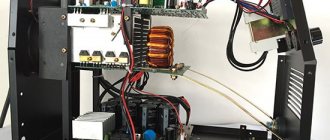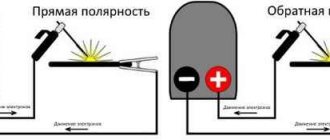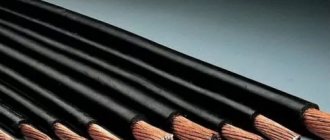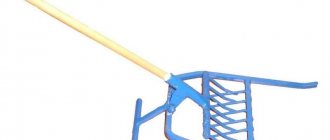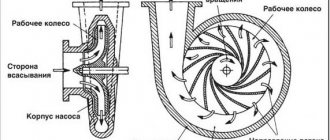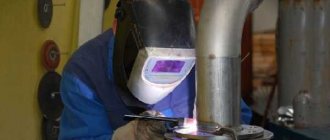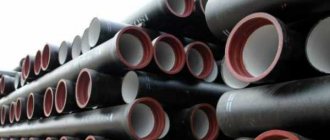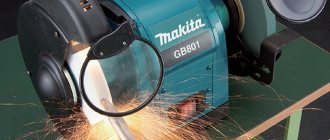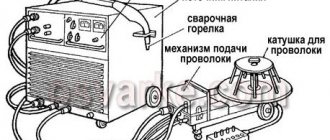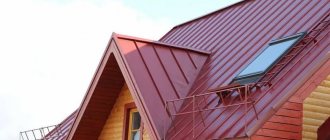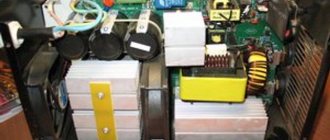Voltage stabilizer for welding inverter
Reading time: 5 minutes
Welding voltage may drop or simply be insufficient due to old wiring or power outages. This problem is especially acute if you cook at the dacha with your own hands. Indeed, in such conditions, no one guarantees you the provision of uninterrupted electricity and a few additional kW. And in some areas the voltage is so low that even a table lamp cannot work properly. In such situations, a stabilizer for a welding inverter comes to the rescue.
Don't think of this device as an unnecessary purchase. Indeed, in some cases you simply cannot do without a stabilizer. If you use a budget machine for welding, then a stabilizer is a must. After all, low-power, inexpensive welding machines are often not able to operate stably. And during power surges they may not turn on at all. We will tell you what a stabilizer is and how to choose it in this short article.
general information
Surely, every home welder has had to deal with one of the most unpleasant problems - an unexpected shutdown of the welding inverter due to a lack of voltage in the household electrical network.
There are two simple solutions to this problem. You can change the diameter of the electrodes by choosing smaller rods. For example, instead of 3 mm, take electrodes with a diameter of 2 mm. This is a controversial solution, but it is effective if you need to finish the job as quickly as possible. However, you will not be able to use this solution if you are welding thick parts. After all, when using an electrode of a smaller diameter, the quality of the seams will deteriorate significantly and the welding itself will become more complicated.
But there is a second solution - the use of third-party devices. Designed to stabilize voltage. A separate voltage stabilizer for a welding inverter will help solve sagging problems once and for all. Or lack of power in the household electrical network. But this is not the most budget option. The cost of a good rectifier can be similar to the price of a welding machine. But it's worth it.
In simple words, a voltage stabilizer for a welding machine (also known as a welding arc stabilizer) is a device for stabilizing or increasing voltage. This device also protects the welding machine from power surges and failure.
The essence of the stabilizer's operation is similar to that of a conventional transformer. Input current is supplied to the primary windings and then output from the secondary windings. If the input voltage is unstable or insufficient, the reactive coil is turned on. Its inductive reactance is adjustable. Or simply adding a few new turns in the secondary coil.
Thus, current losses are compensated and the output voltage increases. And if the output voltage is too high, then the stabilizer works on the reverse principle and occupies it. Therefore, the voltage at the output of the welding machine can be stabilized in the same way as at the input.
As you can see, a stabilizer is an effective and in some cases irreplaceable device. With its help, you don't have to worry about power surges. Once you start welding, you will be confident that you will finish it without any problems. But, despite the fact that the stabilizer is a simple device, it also needs to be chosen correctly. We will talk about how to choose a stabilizer below.
Stabilizer selection
When choosing a voltage stabilizer for a welding inverter, pay attention to several characteristic features.
If you have a standard 220V for a welding machine, but at the outlet you get much less voltage, then you should not buy a stabilizer for the inverter. It will not completely solve this problem. It is better to buy a stabilizer for the entire electrical network and turn it on at the input. Then this will make sense. You will be able to use not only the inverter, but also other equipment without interruption. And the resulting power is enough for the welding machine.
When choosing a stabilizer, the reactive power of your inverter is no less important. You may not even calculate this indicator. Just measure how much your inverter consumes at the input. At the same time, set the mode in which you often work. When purchasing, consider the power of your inverter welding machine. The power of the stabilizer should be approximately the same as that of the inverter. But not much more. Otherwise, you simply will not realize the full potential of the device, and you will overpay for increased power. By choosing the right stabilizer characteristics, you can save a lot of money.
Also pay attention to the speed of the stabilizer. It should be fast, without significant delays. Manufacturers produce two types of devices: electronic and electromechanical with a servo drive. Electronic stabilizers work faster and are more expensive. It is the ideal companion for a welding inverter. Electromechanical stabilizers cannot boast the same speed as electronic ones. But they are more reliable and durable. At the same time they are cheaper.
How to choose a device
If you need to choose a stabilizer, there are some important details to consider. They will help you avoid making mistakes when purchasing.
If you have a regular 220 V and you work with a welding inverter, but end up getting less current, buying a controller will not be justified. An excellent solution would be the device and its installation throughout the entire electrical network.
You will be working with it on incoming voltage. You will feel the effect and will be able to use both an inverter and other serious equipment. The power will be enough for the welding machine to turn on uninterruptedly.
When you are thinking about purchasing a stabilizer, consider the reactive power of the welding units. It is not necessary to calculate indicators.
About the types of welding machines
When purchasing or renting welding equipment, there are a number of important criteria to consider. The most important of them is the type of device
.
- He can be:
- welding inverter;
- AC transformer device;
- DC transformer device;
- semi-automatic welding device.
Welding machines that use alternating current
, are the most popular. They are used for welding using consumable electrodes. Such devices are characterized by durability, high reliability and simplicity of design.
DC devices
also used for welding using consumable electrodes. The only thing in which they differ from the previous type of welding devices is the presence of a diode-type output rectifier, which ensures the formation of direct current from alternating current. But at the same time, the device loses a significant part of its power and becomes more complex in terms of design. A DC welding device is much more convenient to use due to the presence of a constant arc.
Semi-automatic welding machines
characterized by good performance, ease of use and sophisticated design. Devices of this kind are used for gas welding. If the latter is not used, then a special flux-cored wire is used.
The most convenient and modern among all welding devices are inverters
, characterized by low weight, compactness and resistance to significant voltage surges. With the help of welding inverters, welding is performed as conveniently as possible, and the quality of the result is beyond any doubt. All this is possible thanks to the use of various additional functions, for example, a stabilizing system, accelerated ignition of the working arc and protection against possible voltage surges.
Application of rectifiers
Devices with high-power direct current allow welding with coated electrodes on many types of steel. Depending on the adjustment capabilities, some units are capable of welding metals up to 50 mm thick (with edge preparation). By adjusting the rectifier back, the welder is able to make connections on thin products with a wall thickness of 1 mm.
The welding device is capable of melting both the edges of the base metal and the electrode rods. The diameter of the latter varies from 2 to 6 mm. In addition to coated electrodes, rectifiers can work with filler wire supplied from a coil. To do this, they are actively being introduced into semi-automatic devices.
Welding current converters are also used for welding with non-consumable electrodes (tungsten, carbon). In this case, the weld pool is protected with inert gases supplied to the torch through a cable channel. So, using a welding rectifier, you can weld cast iron, stainless steel, and low-carbon steel.
In addition to welding, the units are used for cutting metals with an electric arc. This action is possible due to an increase in current strength, which burns through the steel, preventing the edges of the hole from coming together again. Unlike transformers, direct current converters allow you to save electrodes for the same amount of work.
About voltage stabilizers for welding
The use of voltage stabilizers for various types of equipment allows us to ensure correct operation under conditions of mains voltage fluctuations and extend its service life. By the way, if you are looking for a voltage stabilizer for a welding machine
, then it is important to remember that it cannot be placed after a working transformer welder, as many indicate in the operating instructions for the devices. However, a stabilizer can protect your devices during voltage surges resulting from the operation of a neighbors welding machine. It can also be installed after an inverter welding machine.
You should choose a voltage stabilizer based on the maximum power of all devices
, which will simultaneously operate on the line, as well as measurements of the input voltage.
These measurements are best taken with a multimeter at different times of the day. In this way, you can find out the amplitude of the mains voltage fluctuations
and, based on it, choose the right single-phase voltage stabilizer.
We also note that many modern welders have a soft start function, in which there is no increased starting current. In this case, you do not need to make a 3-4 times power reserve, as some sellers of voltage stabilizers may recommend to you. A power reserve is necessary if devices with powerful electric motors, such as pumps for pumping water, will operate on the line. Also keep in mind that most manufacturers specify power ratings for input voltages of 190 volts or more. If the voltage drop is more significant, it is no longer possible to turn on household appliances and equipment on the line with a total power equal to the rated power of the stabilizer. At an input voltage of 140-150 volts, for most brands of stabilizers, the power is reduced by about 2 times. As an exception, we cite the Stabvolt and Skat brands, whose design uses high-quality transformers with a sufficient number of turns to ensure good overload capacity and compliance with the declared power over the entire range of input voltages.
Classification by type: multi-post, single-post and others
There are several types of welding rectifiers.
Welding station is a welder’s workplace. Rectifiers have designs that can serve both one post and several at the same time. If everything is clear with one post, then how a group of posts functions without influencing each other needs to be explained.
Welding 4-station rectifier VDM-6303S. Photo VseInstruments.ru
Independence in operation is determined by the constant open circuit voltage of each post . This is ensured by a rigid current-voltage characteristic. With a falling characteristic, a short circuit at a single station would reduce the voltage at other posts and stop welding. Each post has an additional variable resistance to regulate the current.
A multi-station welding rectifier is used in industrial settings . Single-station welders are used by non-professional welders.
Welding rectifier ETA VD-306 B 3x380. Photo VseInstruments.ru
The main property for classifying welding rectifiers is the difference in the characteristics of the output rectified voltage from the welding current. Depending on this characteristic ( flat, steep or universal ), the applicability of the rectifier to one or another welding technology is determined.
Steeply falling characteristic - for manual arc welding with coated piece electrodes, argon arc welding with tungsten electrodes, mechanized submerged arc welding on machines with regulation of the electrode wire feed depending on the arc voltage.
Rectifiers with a flat-sloping characteristic are used for mechanized welding with a consumable electrode in a shielding gas environment or submerged arc, at a constant wire feed speed, independent of the arc voltage. The manufacturer obtains these characteristics by adjusting the transformer, adjusting the inductive reactance of the inductor, or using semiconductor devices. First of all, it is important to know what kind of work the welding rectifier is suitable for and its parameters.
- Transformer. Moving coils are located inside the power transformer. Primary adjustment is made by switching the windings from a star to a delta circuit. Fine adjustment occurs by changing the distance between the windings.
- Transistor. A semiconductor operates on the switch principle. The transistor is configured for a certain current value. In this case, the regulation of the strong current occurs at the expense of the weaker one. This control method expands the range of applied welding currents.
- With saturation throttle adjustment. Typically, the inductor (inductive reactance) is located between the transformer and the rectifier unit. The power transformer produces constant voltage. The use of inductive reactance allows you to change the parameters and the rectifier will already operate on a falling current-voltage characteristic.
- Thyristor. Here the voltage and current are controlled using an electronic circuit. The circuit has a trimming element through which the voltage and current supplied to the electrode at the welding site are adjusted.
- Inverter welding rectifiers. The welding current is adjusted according to a completely different principle. Electronic devices are capable of autonomously regulating high-frequency welding current and avoiding increasing current by reducing voltage.
Inverter rectifier Battleship VD-201I. Photo Welding Technologies
Welding rectifiers are divided into household ones , with a power not exceeding 200 A, semi-professional (power up to 300 A) and professional (over 300 A). Models differ in power, size and amount of energy absorbed.
Welding inverter rectifier Foxweld VD-306I, maximum current – 315 A. Photo VseInstruments.ru
Basic technical data of rectifiers: supply voltage and no-load voltage, maximum operating power, power consumption, type of welding current, electrode diameter, weight and dimensions. Different types of rectifiers are designed for different jobs - for example, VD2-313 is used for two-station arc welding of steel objects, and VDU-506 is a universal rectifier, capable of completing automatic welding machines and powder welding.
Different types of rectifiers are designed for different jobs - for example, VD2-313 is designed for two-station arc welding of steel objects, and VDU-506 is a universal rectifier, capable of completing automatic welding machines and powder welding.
Criteria for selecting a welding stabilizer
High-quality low-power welding machines with a built-in or external welding arc stabilizer attract the attention of most private farm owners who constantly need their services.
Such devices, without any special complications, allow you to use welding equipment even in conditions of very unstable voltage, which is typical for rural regions of the country.
Such a stabilizer would also be useful for a city welder, who is also familiar with the effect of “subsidence” or strong fluctuations in the parameters of the supply network.
Operating principle and device
Voltage drops are especially common in densely populated areas of the city, when consumers living in nearby houses turn on all their household appliances at the same time.
As a result, the network may “sag” below a certain level (less than 180 Volts), at which it becomes very problematic to ignite an electric arc. A welding stabilizer helps save the situation.
A network stabilizer belongs to a class of electrical devices designed to protect welding equipment from significant fluctuations in network parameters. It allows you to maintain an arc discharge of the required power.
The principle of operation of some welding stabilizers is similar to the operation of an autotransformer, in which the input voltage is converted due to the inductive coupling of the primary winding with the secondary circuit.
When the input signal drops below normal, an additional reactive coil with variable inductance is activated in the secondary circuit or the required number of turns is automatically added. Such transformations of secondary circuit parameters lead to compensation of input signals, which are artificially restored to normal values.
When the parameters of the supply network are too high, when the currents in it increase significantly, the built-in regulator performs the opposite effect. It ensures the stability of the voltage supplied to the converter.
Other methods of voltage stabilization involve the use of special equipment (rectifiers or inverters) to achieve the same effect. In these devices, loss compensation is carried out electronically, due to specially constructed conversion circuits.
Main settings
The technical characteristics of welding stabilizers are determined by their specific purpose, that is, by the equipment that they must maintain in working condition. According to this requirement, all welding stabilizers can be divided into the following groups:
- devices supporting semi-automatic welding operating modes;
- stabilization devices of the so-called “inverter” type;
- voltage stabilizers for welding machines in standard design.
The first of these modifications is relatively inexpensive, but has a slower response to sudden changes in voltage in the network and is noisier. Inverter welding stabilizers are much more expensive in terms of price, but they have a shorter response time and are more compact.
Conventional electromechanical stabilizers should be classified as a budget option for protective devices, the capabilities of which correspond to their cost.
General recommendations
When it is difficult to independently select a stabilizer for a welding machine, turn to specialists. He will select equipment that can ensure safe welding. When funds are available, preference is given to modern inverter-type electronic devices on microcircuits.
Electrical equipment can be three-phase or single-phase, connected to a standard electrical network. It is necessary to take into account the characteristics of power sources. Another nuance: inverter manufacturers initially overestimate some current parameters to ensure safe operation of welding machines. It is advisable to measure the actual power at maximum load. Stabilizing equipment is selected based on this indicator.
For low-power welding machines, 3 kVA devices are sufficient; for powerful ones, 8 to 10 kVA are required. Transformer-type electrical equipment responds only to significant network “drawdowns”. Electronic zener diodes are more sensitive and operate in constant mode.
Knowing the features of stabilizing devices, the welder will be able to protect the welding machine from power surges.
Source
Choosing the right device
Even with slight instability of the supply current in the home electrical network, any welders are faced with certain problems, which everyone tries to solve in their own way.
One way to overcome these difficulties involves the use of thinner electrodes, allowing for some time to work under conditions of reduced power. However, at very low mains voltage values, even this practice-tested technique is not a way out of the current situation.
The only right solution in this situation is to purchase a reliable and inexpensive external welding stabilizer, when choosing which you must consider the following points:
- first of all, you need to pay attention to the type of supply voltage with which this device is intended to work (two-phase or three-phase);
- you should immediately decide on such an important parameter as the power of the stabilizer for a semi-automatic machine or inverter (it should be at least 5-8 kW);
- and finally, a rather important point is the type of welding stabilizer, determined according to the principle of its operation (discussed above).
Adjusting the welding current
The welding current in the rectifier is adjusted using electromechanical or electrical methods. Electromechanical adjustment of welding current involves performing this operation before the rectifier unit . In this case, the rectifying valves are supplied with alternating current, which already has the parameters required for welding. Electrical adjustment is possible on rectifiers equipped with thyristors, and consists of changing the angle of their adjustment.
Advice from experienced welders
When choosing a suitable stabilizer, it is necessary to take into account the opinions of experienced welding operators, which usually boil down to the following comments.
First of all, taking into account the purpose of the purchased product, it would be preferable to purchase an inverter-type electronic stabilizer, since its versatility allows it to be used in any welding conditions. The only obstacle to this will be the availability of appropriate funds for its purchase.
Next, before going to the store, you should decide on such an important characteristic as the response time of the stabilizing device to changes in the supply voltage.
A product with characteristics suitable for this indicator will protect welding equipment from accidental damage and provide an instant response to changes in operating conditions.
If there are significant fluctuations in the input power (up to 150 Volts), a solution may be to install a separate autotransformer at the input to a private house . With its help, it is possible to adjust the voltage to the required value, bringing the parameters of the supply network to normal.
Which stabilizer should I choose – electronic or electromechanical?
The preferred installation option would be the electronic version, but many consumers are frightened by its final price, which is truly inflated.
Electronic voltage stabilizer
But the use of an electromechanical version of the device will not greatly impact the consumer’s pocket. If the first electronic option is characterized by almost instantaneous response to a voltage surge, then the second option provides a certain time interval, which in some cases negatively affects the operation of inverter equipment, and indeed all devices connected to the general energy consumption network.
The electromechanical stabilizer, despite its low cost, has a number of shortcomings that will manifest themselves during the operation of the welding machine:
- Natural noise of the device.
- There are rubbing elements of the parts.
- After a certain period of operation, a built-in element.
In any case, experts believe that purchasing a stabilizer will only partially solve the issues of integrity and safety of the operation of inverter equipment and will help ensure the quality of welding work. At the same time, the general recommendation, in addition to purchasing the device, is to install transformer units to increase when supplying voltage to the house. As practice shows, most often instead of the specified 220 Volts, the network actually has 180-190 Volts, and in remote areas it does not exceed 150 Volts at all.
About voltage stabilizers for welding
A welding stabilizer is an electrical device used to stabilize the current supply to welding equipment. Protects them from damage due to network surges.
The device operates on the principle of a transformer, where the input current is supplied to the primary windings and output from the secondary windings. When the input voltage drops, the variable inductance coil is activated, or more turns are added in the secondary winding to compensate for the loss and increase the output voltage. If the input is too high, the opposite effect occurs, and therefore the output voltage remains practically unchanged.
There are the following types of 220 V voltage stabilizers for welding:
They also highlight:
- semi-automatic;
- welding machines with a gasoline or diesel generator.
